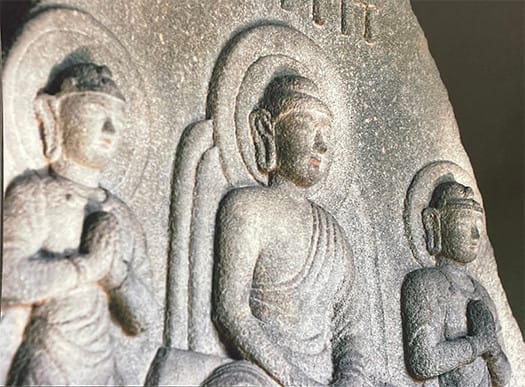

仏像に興味を持ち始めるというのは高齢化の進展なのでしょうか(笑)。
歴史の古道を訪ね歩くようになると徐々にその魅力に引き込まれるのかなぁ。
写真の石像と銅造はそれぞれ奈良県桜井市・石位寺の「薬師三尊石仏」と、奈良県明日香の「飛鳥大仏」。どうもこの2体の仏像の表情に完全にトリコにされている。
2枚目の飛鳥大仏は日本最初の仏教寺院とされる飛鳥寺の本尊で、産経新聞にはこんな紹介。「飛鳥大仏は609年には完成し、鋳造年が絞れる仏像としては日本で最古級。面長の顔やアーモンドのような形をした目は大陸の影響が色濃く、江戸時代に飛鳥大仏と対面した国学者、本居宣長(もとおりのりなが)は「菅笠日記」に「げにいとふるめかしく、たふとく見ゆ」との一文を残している。」
わたしが歴史に興味を持ち始めた小学校の社会科の授業で、いちばん最初に覚えた美術家の名は「止利仏師」だった記憶が鮮明にある。はるかに時間を超えてその作家の実物と間近く接して、作り手やそのモデルとなった人物の表情の豊かさに完全にノックアウトされた。最古級であるのに国宝には指定されていない。それは幾度か火災にあって補修されてきていることが原因とか。しかしそれは同時に歴史的に多くの人びとの尊崇を集め続けてきたことをも如実に語っていると思う。・・・まぁ国宝であるかどうかそんなことはどうでもいいけれど。
一方、最近拝見した1枚目の写真の「薬師三尊石仏」。こちらは無住寺「石位寺」にあり、今は桜井市忍阪区の住民が交代で維持管理していてWEB申込みして拝観することができる。白鳳時代(644年〜710年)に製作された薬師三尊石仏でわが国最古の石仏として国の重要文化財指定。写真は拝観したときに購入させていただいたプリント写真。この石仏さんは天武天皇の妃であった額田王が願主として伝わっている。2020年初頭にはじめて「東京国立博物館」で展示公開されてスターダムに押し上げられた(笑)という。

わたしは最近その存在を知り石位寺で参観させていただいた。お寺に行くのに狭い道に迷ってしまった苦い記憶もある(泣)。しかしこのご尊顔を拝見して、一気にゾッコンにさせられてしまった。なんといっても「美しい」。石仏ということで正面写真と紹介文を読んでいただけの印象では「ふーん」と思っていたものが、現物をじっくり見て前後左右からその美顔を拝ませていただいて完全KO(笑)。
よくみると唇にはうすい紅までほどこされた残照があって、ふくよかな肌の優美さまでが伝わってくる。白村江に海外派遣された兵士たちを鼓舞する彼女の歌が万葉に残されている。「熟田津に船乗りせむと月待てば潮もかなひぬ今は漕ぎ出でな」。月明かりのなか朗々と歌い上げる美女の姿に、多くの兵士が奮い立ったとされる。その歴史美女の印象がこの石仏からリアリティを持って伝わってきた。
高齢化のせいで仏像趣味が・・・と思われたけれど、むしろ逆で石や金属という物質に乗り移った魂魄のようなものに気付けるようになった、そんな豊かさを深く感じさせられている。
English version⬇
Asuka Hakuho's Buddhist Statues with Light Lipstick and Fragrance (The 37,000 Year History of the Archipelago, Vol. 58)
The ancient beauty who sang "I want to go sailing to Mukidazu," is a reality with a faint lipstick. A girl who transcends time. A girl who transcends time.
I wonder if it is the aging of the population that begins to take an interest in Buddhist statues (laughs).
I wonder if I am gradually drawn to their charms as I begin to visit and walk along the ancient paths of history.
The stone and bronze statues in the photo are "Yakushi Sanzon Ishibutsu" at Ishiiji Temple in Sakurai City, Nara Prefecture, and "Asuka Daibutsu" in Asuka, Nara Prefecture, respectively. Apparently, I am completely tricked by the expressions of these two Buddhist statues.
The second one, Asuka Daibutsu, is the principal image of Asukadera Temple, which is considered to be the first Buddhist temple in Japan. Asuka Daibutsu was completed in 609 and is one of the oldest Buddhist statues in Japan for which the year of casting can be narrowed down. The long face and almond-shaped eyes are strongly influenced by the continent, and the national scholar Motoori Norinaga, who met the Great Asuka Buddha in the Edo period, wrote in his "Sugakasa Nikki" (Diary of Sugakasa), "It is a very beautiful and beautiful statue.
I have a vivid memory that the name of the first artist I memorized in my elementary school social studies class, when I first became interested in history, was the "Buddhist priest Toryo" (止利仏師). Having come into close contact with the artist's actual works of art far beyond time, I was completely knocked out by the richness of the expressions on the faces of the creators and their models. Although it is one of the oldest, it is not designated as a national treasure. This is due to the fact that it has been repaired after several fires. However, I think it also shows that it has been historically revered and respected by many people. Well, I don't care whether it is a national treasure or not.
On the other hand, I recently saw the "Yakushi Sanzon Ishibutsu" in the first photo. This one is located in "Ishiiji," a non-resident temple, and is now maintained by the residents of Oshizaka-ku, Sakurai City, who take turns maintaining it, and you can apply on the web to view it. It is the oldest stone statue of Yakushi Sanzon (three images of Buddha) in Japan, and is designated as a national important cultural property. The photo is a print that I purchased when I visited the temple. The stone Buddha is said to have been the wish-fulfilling deity of King Nukata, the Empress of Emperor Temmu, and was elevated to stardom when it was exhibited for the first time at the Tokyo National Museum in early 2020 (laugh).
I recently learned of its existence and was able to visit it at Ishiiji Temple. I have a bitter memory of getting lost on a narrow road to the temple (tears). However, when I saw his face, I was instantly attracted to him. After all, it is beautiful. I had only read the introduction and seen the front photo of the stone Buddha and thought, "Hmmm," but after seeing the actual statue and admiring its beautiful face from the front, back, left and right, I was completely smitten (laugh).
Upon closer inspection, one can see that her lips are covered with a light crimson color, and even the gracefulness of her plump skin can be felt. Her poem, which was written to inspire the soldiers who were dispatched overseas to the Hakumura River, is preserved in Manyo. The poem is a poem written in Manyo to inspire the soldiers who were sent overseas to the Hakumura River: "Wait for the moon to come and sail to Kyu-ta-tsu, the tide is coming in. It is said that many soldiers were inspired by the sight of this beautiful woman singing in the moonlight. This stone Buddha conveys the impression of this historical beauty with reality.
Although it was thought that the aging of the population had made people less interested in Buddhist statues, I was deeply impressed by the richness of the spirit of the Buddha, which has been transferred to the material of stone and metal.










